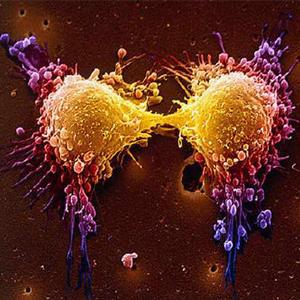Activating aging in tumors: A new way to help lymphoma treatment

To fight some of the cancers, re-activating a process which averts cell proliferation is the key. Similarly scientists found mechanism in the case of large B-cell lymphoma by re-activating a gene that controls the aging of tumors by which they don’t divide. Researchers think this may lead to new drugs for treating cancers. Researchers in Nature Communications report describe the new protein called smurf2 which enforces cell aging in a subset of disseminate large B-cell lymphoma (DLBCL). Senior author Hong Zhang, assistant professor of cell and developmental biology at University of Massachusetts (UMass) Medical School, says:"Restoration of smurf2 expression could help benefits for patients and encourage treatment in difficult cases.”
This usually regulates the aging of cell and prevents division and multiplication of B cells. However patients having DLBCL demonstrate low expression of Smurf2 this in turn affects cell division and tumor growth. The commonest type of non-Hodgkin's lymphoma is DLBCL which is a group of cancers which that begin in the lymph nodes and lymphatic system. 70,000 Americans will be found with non-Hodgkin's lymphoma in 2013 and half of them will not respond to present treatments or will degenerate in 5 years. Co-author Rachel Gerstein, associate professor of microbiology & physiological systems at UMass Medical School, says: "Diagnosis with DLBCL happens in mid-60s so it is exciting to connect a glitch in aging in cell within DLBCL to this cancer which mostly affects the elderly." Previously the team knew that mice lacking the Smurf2 gene advanced in quick development of B-cell lymphoma and other tumors.
The aim of the new study links Smurf2 and human DLBCL and may find out which molecular pathway was involved. A major subset of sample tumor of from patients with DLBCL demonstrated decline in Smurf2 expression with less levels of the protein were related to poor survival projection. Strong role for Smurf2 in human DLBCL is pointed out. Cancer gene, c-Myc, and the transcriptional regulator YY1 were discovered by the researchers when they took close look at the molecular mechanism. The three proteins Smurf2, c-Myc and YY1 control cell division however in a subset of DLBCL patients this team goes wrong. When they refurbished Smurf2 expression in human DLBCL cells it stopped cells from multiplying. With this it was felt that increasing Smurf2 expression in lymphomas may have a positive effect in treatments and help patients.
The team is interested in screening molecules which either increase or mimic Smurf2 expression and want to found out if Smurf2-YY1-c-Myc pathway may affect the same way in other cancers like liver.Prof. Zhang says: "With major clinical application this is another instance of a basic biological finding. At the beginning we were interested in the function of Smurf2 in cellular aging. The striking clinical relevance was unexpected." UK researchers found early this year that reduction in the level of Smurf2 in melanoma cancer cells affected in a 100-fold raise in their sensitiveness to a set of drugs called "MEK inhibitors." Clinical trials are going on the drugs as they don’t affect cancer as expected.








